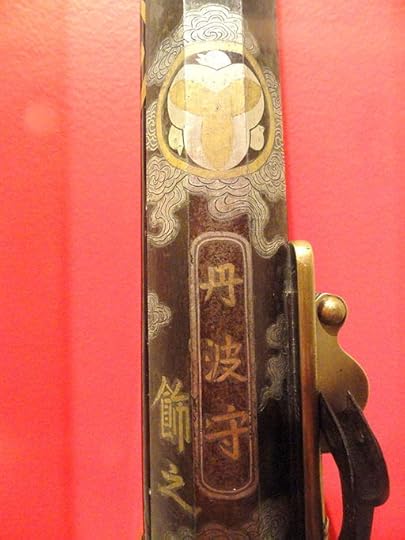Handgun Control in Medieval Japan
Recently, I had the opportunity to visit a nice exhibit of Japanese arms and armor. Toward the end of the exhibit hung two very elegant matchlock guns dating to the Edo period (the 17th century). A small accompanying sign stated that firearms had been introduced into Japan in 1593 when a Portuguese vessel wrecked during a storm. This detail came from the Teppo ki, or Firearms Record of 1606.

Decoration on the stock of a Teppo, Japanese matchlock gun at the Higgins Armory.
As a researcher into the early history of firearms, I was startled. If firearms developed, along with gunpowder, in China early enough to migrate to England by the 14th century, how could they not have reached Japan before the 1593? The answer is, naturally, more complicated than that.
The entire Wikipedia section on this period in Japanese firearms is:
“Due to its proximity with China, Japan had long been familiar with gunpowder. Firearms seem to have first appeared in Japan around 1270, as primitive metal tubes invented in China and called teppō (鉄砲 lit. “iron cannon”) seem to have been introduced in Japan as well.[1]
These weapons were very basic, as they had no trigger or sights, and could not bear comparison with the more advanced European weapons which were introduced in Japan more than 250 years later.[1]“
footnote 1 refers to the text: Perrin, Noel (1979). Giving up the Gun, Japan’s reversion to the Sword, 1543–1879. Boston: David R. Godine. ISBN 0-87923-773-2
Implying that the guns were simply not good enough to bother with. Given that the Japanese were also known for archery, it’s probably true that these early guns couldn’t compete with a competent archer. However, that was true in Europe as well, and especially in England, home of the longbow. It would be centuries before guns became accurate enough to rival the bow and arrow as a killing device. However, those early guns had other uses. Their explosive power and potential often frightened the knights and foot soldiers who first encountered them, and there are medieval stories of troops who left the field when the guns were fired, not because they were hurt, but because of the “shock and awe” effect of the noise, smoke and flash, which were often compared with the presence of Hell.
For a consideration of the period after the Portuguese introduction of firearms (dated to 1543, according to most sources) check out this blog about Guns in Medieval Japan. (despite the title of this entry, he’s talking about the 16th century onward, what historians generally term the Early Modern period) This blogger makes some of the same observations I might, referring to my own period, including the fact that guns, like bows, were a weapon that could be used effectively by a peasant. And, in particular, that they could be used by that peasant to take down a knight–a Samurai, in the Japanese context.
Distance weapons like this constituted a threat to the landed gentry, not merely to their person (they are a threat to everyone in that regard) but rather to their status. The feudal system relied upon certain tenets, one of which is that an armed elite in power over others was a necessity. These people controlled the land, and absorbed much of the income from that land, theoretically in exchange for the protection they offered. So the warrior class became a hierarchy of wealth and status, codifying their prestige into laws and attitudes designed to defend it, with distance weapons being regarded as low-status, cowardly devices that removed the honor from combat.
Does this have implications for the present day, with our shared concerns over personal safety leading to conflicting agendas? The blogger above, Ryo Chijiwa, along with the author of the book cited on Wikipedia both point out that the strict gun control exercised by the Tokugawa Shogunate (which began in the 17th century) coincided with 250 years of peace. It’s hard to say which came first: did the lack of guns result in a peaceful society, or did the peaceful society reject guns because they were deemed unnecessary except in time of war?
It’s interesting to consider what the historical perspective can show us about our contemporary woes. What are your thoughts?





